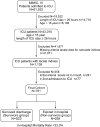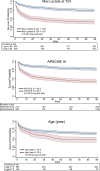Lactate indices as predictors of in-hospital mortality or 90-day survival after admission to an intensive care unit in unselected critically ill patients
- PMID: 32150560
- PMCID: PMC7062275
- DOI: 10.1371/journal.pone.0229135
Lactate indices as predictors of in-hospital mortality or 90-day survival after admission to an intensive care unit in unselected critically ill patients
Abstract
Background: We performed an exclusive study to investigate the associations between a total of 23 lactate-related indices during the first 24h in an intensive care unit (ICU) and in-hospital mortality.
Methods: Nine static and 14 dynamic lactate indices, including changes in lactate concentrations (Δ Lac) and slope (linear regression coefficient), were calculated from individual critically ill patient data extracted from the Multiparameter Intelligent Monitoring for Intensive Care (MIMIC) III database.
Results: Data from a total of 781 ICU patients were extracted, consisted of 523 survivors and 258 non-survivors. The in-hospital mortality rate for this cohort was 33.0%. A multivariate logistic regression model identified maximal lactate concentration at 24h after ICU admission (max lactate at T24) as a significant predictor of in-hospital mortality (odds ratio = 1.431, 95% confidence interval [CI] = 1.278-1.604, p<0.001) after adjusting for predefined confounders (age, gender, sepsis, Elixhauser comorbidity score, mechanical ventilation, renal replacement therapy, vasopressors, ICU severity scores). Area under curve (AUC) for max lactate at T24 was larger (AUC = 0.776, 95% CI = 0.740-0.812) than other indices (p<0.001), comparable to an APACHE III score of 0.771. When combining max lactate at T24 with APACHE III, the AUC was increased to 0.815 (95% CI:0.783-0.847). The sensitivity, specificity, and positive and negative predictive values for the cut-off value of 3.05 mmol/L were 64.3%, 77.4%, 58.5%, and 81.5%, respectively. Kaplan-Myer survival curves of the max lactate at T24 for 90-day survival after admission to ICU demonstrated a significant difference according to the cut-off value (p<0.001).
Conclusions: These data indicate that the maximal arterial lactate concentration at T24 is a robust predictor of in-hospital mortality as well as 90-day survival in unselected ICU patients with predictive ability as comparable with APACHE III score.
Conflict of interest statement
The authors have declared that no competing interests exist.
Figures



Similar articles
-
[Relationship between "1-hour serum lactate" level and 30-day mortality in critical care patients in intensive care unit].Zhonghua Wei Zhong Bing Ji Jiu Yi Xue. 2020 Jun;32(6):737-742. doi: 10.3760/cma.j.cn121430-20200116-00136. Zhonghua Wei Zhong Bing Ji Jiu Yi Xue. 2020. PMID: 32684223 Chinese.
-
Lactate/albumin ratio: An early prognostic marker in critically ill patients.Am J Emerg Med. 2020 Oct;38(10):2088-2095. doi: 10.1016/j.ajem.2020.06.067. Epub 2020 Jun 27. Am J Emerg Med. 2020. PMID: 33152585
-
Effectiveness of predicting in-hospital mortality in critically ill children by assessing blood lactate levels at admission.BMC Pediatr. 2014 Mar 28;14:83. doi: 10.1186/1471-2431-14-83. BMC Pediatr. 2014. PMID: 24673817 Free PMC article.
-
Outcomes in patients requiring intensive care unit (ICU) admission after emergency laparotomy: A retrospective study.Acta Anaesthesiol Scand. 2022 Sep;66(8):954-960. doi: 10.1111/aas.14103. Epub 2022 Jun 19. Acta Anaesthesiol Scand. 2022. PMID: 35686388 Free PMC article. Review.
-
[Cancer patients in the intensive care unit].Med Klin Intensivmed Notfmed. 2021 Mar;116(2):104-110. doi: 10.1007/s00063-021-00795-3. Epub 2021 Feb 16. Med Klin Intensivmed Notfmed. 2021. PMID: 33591384 Review. German.
Cited by
-
Machine Learning Prediction Models for Mortality in Intensive Care Unit Patients with Lactic Acidosis.J Clin Med. 2021 Oct 28;10(21):5021. doi: 10.3390/jcm10215021. J Clin Med. 2021. PMID: 34768540 Free PMC article.
-
Understanding critically ill sepsis patients with normal serum lactate levels: results from U.S. and European ICU cohorts.Sci Rep. 2021 Oct 8;11(1):20076. doi: 10.1038/s41598-021-99581-6. Sci Rep. 2021. PMID: 34625640 Free PMC article.
-
The Efficacy of Sodium Bicarbonate Ringer's Solution and Lactate Ringer's Solution in Patients Undergoing Long-Term Abdominal Open Surgery: A Multicenter Prospective Randomized Controlled Study.Drug Des Devel Ther. 2025 Jun 1;19:4617-4628. doi: 10.2147/DDDT.S514725. eCollection 2025. Drug Des Devel Ther. 2025. PMID: 40486121 Free PMC article. Clinical Trial.
-
The prognostic value of delta-lactate in critically ill children.J Paediatr Child Health. 2023 Feb;59(2):328-334. doi: 10.1111/jpc.16294. Epub 2022 Dec 7. J Paediatr Child Health. 2023. PMID: 36479722 Free PMC article.
-
Significance of lactate clearance in septic shock patients with high bilirubin levels.Sci Rep. 2021 Mar 18;11(1):6313. doi: 10.1038/s41598-021-85700-w. Sci Rep. 2021. PMID: 33737668 Free PMC article.
References
MeSH terms
Substances
LinkOut - more resources
Full Text Sources

